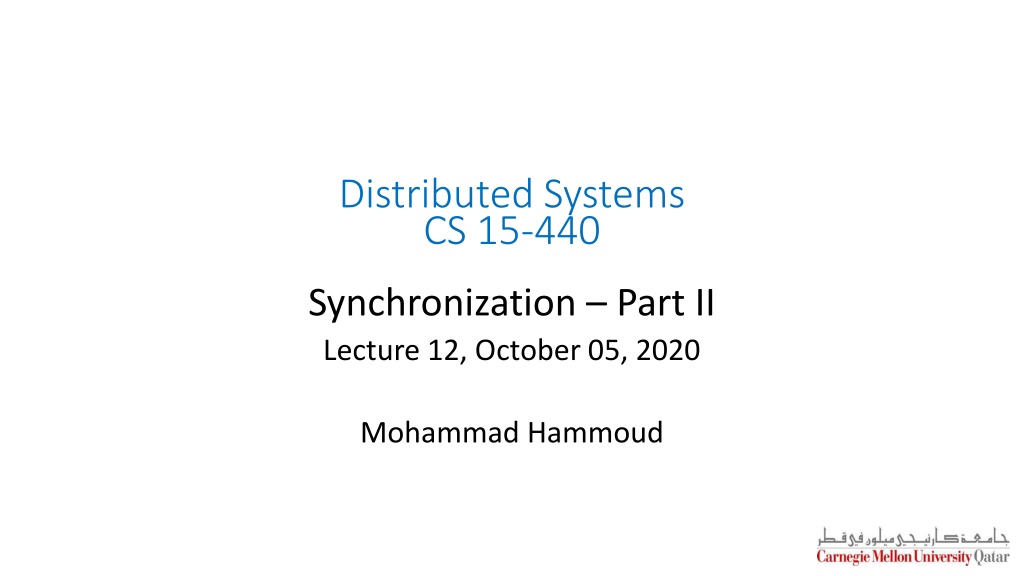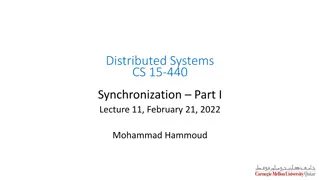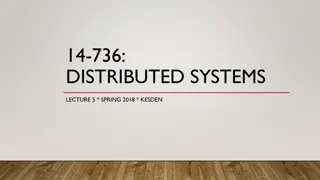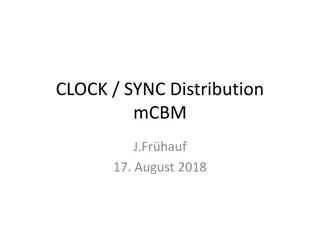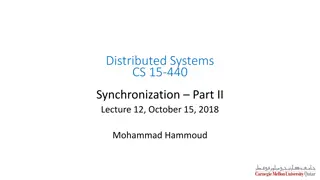Understanding Network Time Protocol (NTP) for Clock Synchronization in Distributed Systems
Dive into the intricacies of Network Time Protocol (NTP) and its role in achieving precise clock synchronization in distributed systems. Explore concepts such as hierarchical organization of NTP servers, NTP protocol operation, and the significance of accurate time tracking for seamless system coordination.
Download Presentation

Please find below an Image/Link to download the presentation.
The content on the website is provided AS IS for your information and personal use only. It may not be sold, licensed, or shared on other websites without obtaining consent from the author. Download presentation by click this link. If you encounter any issues during the download, it is possible that the publisher has removed the file from their server.
E N D
Presentation Transcript
Distributed Systems CS 15-440 Synchronization Part II Lecture 12, October 05, 2020 Mohammad Hammoud
Today Last Session: Synchronization- Part I Physical clock synchronization Today s Session: Synchronization- Part II Logical clock synchronization Announcements: PS3 is due on Oct 12 by midnight Midterm is on Oct 21 (open book and notes)
Clock Synchronization Coordinated Universal Time Tracking Time on a Computer Clock Synchronization Algorithms Cristian s Algorithm Berkeley Algorithm Network Time Protocol
Network Time Protocol (NTP) NTP defines an architecture for a time service and a protocol to distribute time information over the Internet In NTP, servers are connected in a logical hierarchy called synchronization subnet The levels of synchronization subnet is called strata Stratum 1 servers have most accurate time information (connected to a UTC receiver) Servers in each stratum act as time servers to the servers in the lower stratum
Hierarchical organization of NTP Servers This stratum contains the primary servers that are directly connected to the UTC receivers Stratum 1 Stratum 2 are secondary servers that are synchronized directly with primary servers Stratum 2 More accurate time Stratum 3 Stratum 3 synchronizes with Stratum 2 servers End user computers synchronize with the servers in the upper layer stratum Last stratum
Operation of NTP Protocol When a time server A contacts time server B for synchronization If stratum(A) <= stratum(B), then A does not synchronize with B If stratum(A) > stratum(B), then: Time server A synchronizes with B An algorithm similar to Cristian s algorithm is used to synchronize. However, larger statistical samples are taken before updating the clock Time server A updates its stratum stratum(A) = stratum(B) + 1
Discussion of NTP Design Accurate synchronization to UTC time NTP enables clients across the Internet to be synchronized accurately to the UTC Large and variable message delays are tolerated through statistical filtering of timing data from different servers Scalability NTP servers are hierarchically organized to speed up synchronization, and to scale to a large number of clients and servers Reliability and Fault-tolerance There are redundant time servers, and redundant paths between the time servers The architecture provides reliable service that can tolerate lengthy losses of connectivity A synchronization subnet can reconfigure as servers become unreachable. For example, if Stratum 1 server fails, then it can become a Stratum 2 secondary server Security NTP protocol uses authentication to check of the timing message originated from the claimed trusted sources
Summary of Clock Synchronization Physical clocks on computers are not accurate Clock synchronization algorithms provide mechanisms to synchronize clocks on networked computers in a DS Computers on a local network use various algorithms for synchronization Some algorithms (e.g, Cristian s algorithm) synchronize time by contacting centralized time servers Some algorithms (e.g., Berkeley algorithm) synchronize in a distributed manner by exchanging the time information on various computers NTP provides architecture and protocol for time synchronization over wide- area networks such as the Internet
Overview Time Synchronization Clock Synchronization Logical Clock Synchronization Mutual Exclusion Election Algorithms
Why Logical Clocks? Lamport (in 1978) showed that: Clock synchronization is not necessary in all scenarios If two processes do not interact, it is not necessary that their clocks are synchronized Many times, it is sufficient if processes agree on the order in which the events have occurred in a DS For example, for a distributed make utility, it is sufficient to know if an input file was modified before or after its object file
Logical Clocks Logical clocks are used to define an order of events without measuring the physical time at which the events occurred We will study two types of logical clocks 1. Lamport s Logical Clock (or simply, Lamport s Clock) 2. Vector Clock
Logical Clocks We will study two types of logical clocks 1. Lamport s Clock 2. Vector Clock
Lamports Logical Clock Lamport advocated maintaining logical clocks at the processes to keep track of the order of events To synchronize logical clocks, Lamport defined a relation called happened-before The expression a all entities in a DS agree that event a occurred before event b b(reads as ahappened before b ) means that
The Happened-before Relation The happened-before relation can be observed directly in two situations: 1. If a and b are events in the same process, and a occurs before b, then a b is true 2. If a is an event of message m being sent by a process, and b is the event of m (i.e., the same message) being received by another process, then a is true b The happened-before relation is transitive Ifa b and b c, then a c
Time values in Logical Clocks For every event a, assign a logical time value C(a) on which all processes agree (C still corresponds to the process and not to the event, but gets updated when the event happens) Time value for events have the property that: If a b, then C(a)< C(b)
Properties of Logical Clock From the happened-before relation, we can infer that: If two events a and b occur within the same process and a C(b) are assigned time values such that C(a) < C(b) b, then C(a) and If a is the event of sending message m from one process (say P1), and b is the event of receiving m (i.e., the same message) at another process (say, P2), then: The time values C1(a) and C2(b) are assigned in a way such that the two processes agree that C1(a) < C2(b) The clock time C must always go forward (increasing), and never backward (decreasing)
Synchronizing Logical Clocks Three processes P1, P2 and P3 running at different rates P1 P2 P3 0 0 0 If the processes communicate between each other, there might be discrepancies in agreeing on the event ordering Ordering of sending and receiving messages m1 and m2 are correct m1 6 8 10 12 16 20 m2 18 24 30 24 32 40 30 40 50 m3 36 48 60 42 56 70 m4 48 64 80 However, m3 and m4 violate the happened-before relationship 54 72 90 60 80 100
Lamports Clock Algorithm When a message is being sent: Each message carries a timestamp according to the sender s logical clock P1 P2 P3 0 0 0 6 8 10 When a message is received: If the receiver logical clock is less than the message sending time in the packet, then adjust the receiver s clock such that: currentTime = timestamp + 1 12 16 20 18 24 30 24 32 40 30 40 50 m3:60 36 48 60 42 56 61 70 m4:69 48 64 69 80 54 54 70 72 77 90 60 76 80 85 100
Logical Clock Without a Physical Clock Previous examples assumed that there is a physical clock at each computer (probably running at different rates) How to attach a time value to an event when there is no global clock?
Implementation of Lamports Clock Each process Pi maintains a local counter Ci and adjusts this counter according to the following rules: For any two successive events that take place within Pi, Ci is incremented by 1 Each time a message m is sent by process Pi , m is assigned a timestamp ts(m) = Ci Whenever a message m is received by a process Pj, Pj adjusts its local counter Cj to max(Cj, ts(m)) + 1 1. 2. 3. C0=0 C0=1 C0=2 P0 m:2 C1=0 C1=3 P1 C2=0 P2
Placement of Logical Clock In a computer, several processes can use different logical clocks However, instead of each process maintaining its own logical clock, a single logical clock can be implemented in the middleware as a time service Application sends a message Message is delivered to the application Application layer Adjust local clock and timestamp message Adjust local clock Middleware layer Middleware sends a message Message is received Network layer
Limitation of Lamports Clock Lamport s clock ensures that if a b, then C(a) < C(b) However, it does not say anything about any two arbitrary (concurrent or independent) events a and b by only comparing their time values For any two arbitrary events a and b, C(a) < C(b) does not mean that a b Example: P1 P2 P3 0 6 0 8 0 Compare m1 and m3 P2 can infer that m1 m1:6 10 20 30 40 50 60 70 80 90 100 m2:20 m3 12 18 24 30 36 42 48 54 60 16 24 32 40 48 56 64 72 80 m3:32 Compare m1 and m2 P2 cannot infer that m1 m2 or m2 m1 61
Summary of Lamports Clock Lamport suggested using logical clocks Processes synchronize based on the time values of their logical clocks rather than the absolute time values of their physical clocks Which applications in DS need logical clocks? Applications with provable ordering of events Perfect physical clock synchronization is hard to achieve in practice Applications with rare events Events are rarely generated, and physical clock synchronization overhead is not justified However, Lamport s Clock cannot guarantee perfect ordering of events by just observing the time values of two arbitrary events
Logical Clocks We will study two types of logical clocks 1. Lamport s Clock 2. Vector Clock
Vector Clocks Vector clock was proposed to overcome the limitation of Lamport s clock The property of inferring that a occurred before b is known as the causality property A vector clock for a system of N processes is an array of N integers Every process Pi stores its own vector clock VCi Lamport s time values for events are stored in VCi VCi(a)is assigned to an event a If VCi(a) < VCi(b), then we can infer that a causally preceded event b) b (or more precisely, that event a
Updating Vector Clocks Vector clocks are constructed as follows: 1. VCi[i]is the number of events that have occurred at process Piso far VCi[i]is the local logical clock at process Pi Increment VCi whenever a new event occurs 2.If VCi[j]= k, then Pi knows that k events have occurred at Pj VCi[j]is Pi s knowledge of the local time at Pj Pass VCj along with the message
Vector Clock Update Algorithm Whenever there is a new event at Pi, increment VCi[i] When a process Pi sends a message m to Pj: Increment VCi[i] Set m s timestamp ts(m) to the vector VCi When message m is received process Pj : VCj[k] = max(VCj[k], ts(m)[k]) ; (for all k) Increment VCj[j] VC0=(0,0,0) VC0=(1,0,0) VC0=(2,0,0) P0 m:(2,0,0) VC1=(0,0,0) VC1=(2,1,0) P1 VC2=(0,0,0) P2
Inferring Events with Vector Clocks Let a process Pi send a message m to Pj with timestamp ts(m), then: Pjknows the number of events at the sender Pi that causally precede m (ts(m)[i] 1)denotes the number of events at Pi Pjalso knows the minimum number of events at other processes Pk that causally precede m (ts(m)[k] 1)denotes the minimum number of events at Pk VC0=(0,0,0) VC0=(1,0,0) VC0=(2,0,0) P0 m:(2,0,0) VC1=(0,0,0) VC1=(0,1,0) VC1=(2,2,0) VC1=(2,3,0) P1 m :(2,3,0) VC2=(2,3,1) VC2=(0,0,0) P2
Enforcing Causal Communication Assume that messages are multicast within a group of processes, P0, P1 and P2 To enforce causally-ordered multicasting, the delivery of a message m sent from Pi to Pj can be delayed until the following two conditions are met: ts(m)[i] = VCj[i] + 1 (Condition I) ts(m)[k] <= VCj[k] for all k != i (Condition II) Assuming that Pi only increments VCi[i] upon sending m and adjusts VCi[k] to max{VCi[k], ts(m)[k]} for each k upon receiving a message m VC0=(0,0,0) VC0=(1,0,0) VC0=(1,1,0) P0 m:(1,0,0) m:(1,1,0) VC1=(0,0,0) VC1=(1,0,0) VC1=(1,1,0) P1 VC2=(1,1,0) VC2=(1,0,0) VC2=(0,0,0) P2 VC2=(1,1,0) Condition II does not hold Delay delivery
Summary Logical Clocks Logical clocks are employed when processes have to agree on relative ordering of events, but not necessarily actual time of events Two types of logical clocks: Lamport s Logical Clocks Supports relative ordering of events across different processes by using the happened-before relationship Vector Clocks Supports causal ordering of events
Overview Time Synchronization Clock Synchronization Logical Clock Synchronization Mutual Exclusion Election Algorithms
Need for Mutual Exclusion Distributed processes need to coordinate to access shared resources Example: Writing a file in a Distributed File System Client C Client A P1 Server Write to file abc.txt Read from file abc.txt P3 Distributed File abc.txt Client B P2 Write to file abc.txt In uniprocessor systems, mutual exclusion to a shared resource is provided through shared variables or operating system support However, such support is insufficient to enable mutual exclusion of distributed entities In distributed systems, processes coordinate accesses to a shared resource by passing messages to enforce distributed mutual exclusion 32
Types of Distributed Mutual Exclusion Mutual exclusion algorithms are classified into two categories 1. Permission-based Approaches Request to access Coordinator C1 A process, which wants to access a shared resource, requests the permission from one or more coordinators Client 1 Grant P1 Server Access Resource 2. Token-based Approaches Server Each shared resource has a token Resource Token is circulated among all the processes Access Access Access Client 1 Client 2 Client 3 A process can access the resource if it has the token P1 P2 P3 Token Token Token 33
Overview Time Synchronization Clock Synchronization Logical Clock Synchronization Mutual Exclusion Permission-based Approaches Token-based Approaches Election Algorithms
Permission-based Approaches There are two types of permission-based mutual exclusion algorithms 1. Centralized Algorithms 2. Decentralized Algorithms Let us study an example of each type of algorithms 35
A Centralized Algorithm One process is elected as a coordinator (C) for a shared resource Coordinator maintains a Queue of access requests Whenever a process wants to access the resource, it sends a request message to the coordinator to access the resource P0 P1 P2 When the coordinator receives the request: If no other process is currently accessing the resource, it grants the permission to the process by sending a grant message If another process is accessing the resource, the coordinator queues the request, and does not reply to the request Grant Grant Req Req Rel Access Access C Resource P2 P1 Queue The process in action releases the exclusive access after accessing the resource Afterwards, the coordinator sends the grant message to the next process in the queue 36
Discussion (+) Flexibility: Blocking versus non-blocking requests The coordinator can block the requesting process until the resource is free Or, the coordinator can send a permission-denied message back to the process The process can poll the coordinator at a later time Or, the coordinator queues the request (without blocking the requestor). Once the resource is released, the coordinator will send an explicit grant message to the process (+) Simplicity: The algorithm guarantees mutual exclusion, and is simple to implement (-) Fault-Tolerance Deficiency Centralized algorithm is vulnerable to a single-point of failure (at coordinator) Processes cannot distinguish between dead coordinator and request blocking (-) Performance Bottleneck In a large-scale system, single coordinator can be overwhelmed with requests37
Next Class Mutual Exclusion How to coordinate between processes that access the same resource? Election Algorithms Here, a group of entities elect one entity as the coordinator for solving a problem
